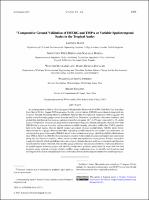Comparative ground validation of IMERG and TMPA at variable spatiotemporal scales in the tropical Andes
Metadata
Show full item recordAbstract
An initial ground validation of the Integrated Multisatellite Retrievals for GPM (IMERG) Day-1 product from March 2014 to August 2015 is presented for the tropical Andes. IMERG was evaluated along with the Tropical Rainfall Measuring Mission (TRMM) Multisatellite Precipitation Analysis (TMPA) against 302 quality-controlled rain gauges across Ecuador and Peru. Detection, quantitative estimation statistics, and probability distribution functions are calculated at different spatial (0.1°, 0.25°) and temporal (1 h, 3 h, daily) scales. Precipitation products are analyzed for hydrometeorologically distinct subregions. Results show that IMERG has a superior detection and quantitative rainfall intensity estimation ability than TMPA, particularly in the high Andes. Despite slightly weaker agreement of mean rainfall fields, IMERG shows better characterization of gauge observations when separating rainfall detection and rainfall rate estimation. At corresponding space-time scales, IMERG shows better estimation of gauge rainfall probability distributions than TMPA. However, IMERG shows no improvement in both rainfall detection and rainfall rate estimation along the dry Peruvian coastline, where major random and systematic errors persist. Further research is required to identify which rainfall intensities are missed or falsely detected and how errors can be attributed to specific satellite sensor retrievals. The satellite-gauge difference was associated with the point-area difference in spatial support between gauges and satellite precipitation products, particularly in areas with low and irregular gauge network coverage. Future satellite-gauge evaluations need to identify such locations and investigate more closely interpixel point-area differences before attributing uncertainties to satellite products.
The following license files are associated with this item:








